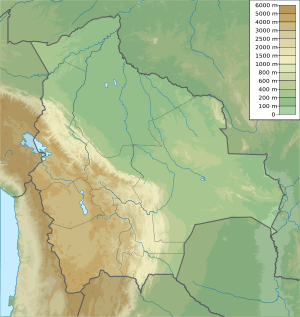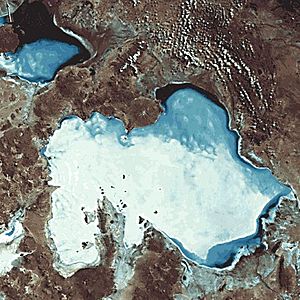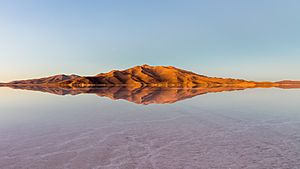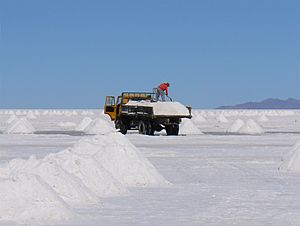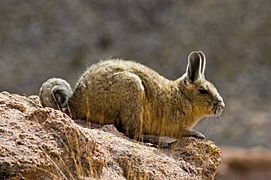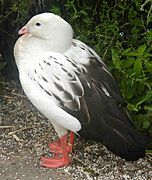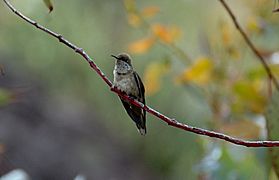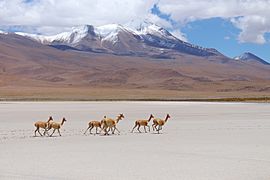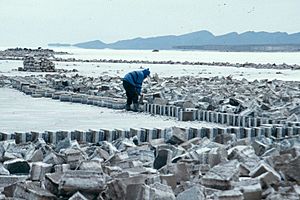Salar de Uyuni facts for kids
Quick facts for kids Salar de Uyuni |
|
|---|---|

Hexagonal formations on the surface of the Salar de Uyuni as a result of salt crystallization from evaporating water
|
|
| Location | Daniel Campos Province, Potosí Department |
| Coordinates | 20°08′01.59″S 67°29′20.88″W / 20.1337750°S 67.4891333°W |
| Elevation | 3,663 metres (12,018 ft) |
| Area | 10,582 square kilometres (1,058,200 ha) |
| Depth | 130 metres (430 ft) |
| Formed by | Evaporation |
| Geology | Salt pan, dry lake |
The Salar de Uyuni is the biggest salt flat in the world. It covers more than 10,000 square kilometers (about 3,860 square miles). You can find it in southwest Bolivia, high up in the Andes mountains. It's about 3,656 meters (12,000 feet) above sea level!
Long, long ago, about 40,000 years ago, this area was covered by huge lakes. Over time, these lakes dried up, leaving behind the giant salt flat we see today. Today, the Salar is covered by a thick layer of salt, several meters deep. This salt crust is incredibly flat! Underneath the salt, there's a salty water mixture called 'brine.' This brine has a lot of lithium, which is used in batteries.
Because the Salar is so big, flat, and has clear skies, it's perfect for helping satellites measure distances from space. After it rains, a thin layer of calm water turns the Salar into the world's largest natural mirror. It's like looking at a giant reflection of the sky!
The Salar is an important travel route across the Bolivian Altiplano. It's also a special place where several types of flamingos come to breed. The Salar de Uyuni is also a climate zone where big clouds from the east can't pass beyond its drier western edges.
The Salar has been used as a filming spot for movies. These include Star Wars: The Last Jedi (2017), The Fall (2006), and Salt and Fire (2016).
Contents
How the Salar de Uyuni Formed
The Salar de Uyuni is part of the Altiplano in South America. The Altiplano is a high plateau that formed when the Andes mountains rose up. This plateau has both fresh and saltwater lakes, as well as salt flats. It is surrounded by mountains and has no rivers flowing out of it.
A Look Back in Time
The Salar's history involves several huge lakes that changed over time. About 30,000 to 42,000 years ago, this area was part of a giant lake called Lake Minchin. This lake later became Paleo Lake Tauca, which was about 140 meters (460 feet) deep.
The youngest prehistoric lake was Coipasa. When it dried up, it left behind two modern lakes, Poopó and Uru Uru. It also left two large salt deserts: Salar de Coipasa and the much bigger Salar de Uyuni. The Salar de Uyuni is about 100 times larger than the Bonneville Salt Flats in the United States.
Underneath the Salar de Uyuni's surface is a layer of mud mixed with salt. This mud is soaked in brine, which is a very salty water solution. The brine contains sodium chloride, lithium chloride, and magnesium chloride. On top of this is a solid salt crust, which can be from a few centimeters to several meters thick.
In the middle of the Salar, there are a few islands. These are the tops of old volcanoes that were underwater when Lake Minchin existed. They have unusual, delicate structures that look like coral. They also contain fossils and old algae.
Weather at the Salar
The temperature here stays fairly steady. It's warmest from November to January, around 21°C (70°F). It's coolest in June, around 13°C (55°F). Nights are cold all year, with temperatures between -9°C and 5°C (16°F and 41°F).
The air is usually dry, with humidity between 30% and 45%. There's not much rain from April to November, only about 1 to 3 millimeters (0.04 to 0.12 inches) per month. In January, it can rain more, up to 80 millimeters (3.1 inches). But even in the rainy season, there are usually fewer than 5 rainy days each month.
Money and Resources
The Salar de Uyuni is part of the "Lithium Triangle." This area has huge amounts of sodium, potassium, lithium, and magnesium. Bolivia has about 7% of the world's known lithium, and most of it is in the Salar de Uyuni.
Lithium is found in the brine under the salt crust. It's fairly easy to get out by drilling into the crust and pumping the brine. Satellites have helped map where the brine is, and ground tests have confirmed it.
Local people have been against foreign companies mining lithium here. They worry that the money from mining won't help their communities. The lithium in the Salar also has more impurities, and the wet climate and high altitude make it harder to process.
Currently, there are no large mining plants at the site. The Bolivian government wants to work with a German company to produce lithium.
The Salar de Uyuni is thought to hold 10 billion tons of salt. Less than 25,000 tons are taken out each year. All the salt miners here belong to a local cooperative. Because it's so big and flat, the Salar is a main route for cars across the Bolivian Altiplano. This is true except when it's covered with water during the rainy season.
What's in a Name?
The word Salar means "salt flat" in Spanish. Uyuni comes from the Aymara language and means "pen" (like an animal enclosure). Uyuni is also the name of a town that many tourists visit before going to the Salar. So, Salar de Uyuni can mean "salt flat with enclosures," possibly referring to the islands in the Salar. Or it could mean "salt flat at Uyuni."
An Aymara legend says that the mountains around the Salar—Tunupa, Kusku, and Kusina—were once giant people. Tunupa married Kusku, but he left her for Kusina. Tunupa cried while feeding her son. Her tears mixed with her milk and formed the Salar. Many local people believe Tunupa is an important god. They say the place should be called Salar de Tunupa instead of Salar de Uyuni.
Plants and Animals
-
A part of Incahuasi Island inside the Salar, with giant cacti.
-
Bolivian vizcacha.
-
Andean flamingos in the Laguna Colorada, south of the Salar.
The Salar has very little wildlife or plants. The main plants are giant cacti, like Echinopsis atacamensis pasacana. These cacti grow about 1 centimeter (0.4 inches) per year and can reach 12 meters (39 feet) tall.
Other plants include Pilaya, which locals use for colds, and Thola (Baccharis dracunculifolia), which is burned as fuel. You can also find quinoa plants and queñua bushes.
Every November, the Salar de Uyuni becomes a breeding ground for three types of South American flamingos. These include the Chilean, Andean, and the rare James's flamingos. They eat tiny brine shrimps found in the Salar. About 80 other bird species live here, such as the horned coot, Andean goose, and Andean hillstar. The Andean fox, or culpeo, is also present. Islands in the Salar, especially Incahuasi Island, are home to groups of rabbit-like viscachas.
Visiting the Salar
Salt Hotels
The Salar de Uyuni is a very popular place for tourists. Because there aren't many regular building materials, many hotels here are built almost entirely from salt blocks. The walls, roof, and even the furniture are made of salt!
The first salt hotel, called Palacio de Sal, was built in the middle of the salt flat between 1993 and 1995. It quickly became a popular spot. However, its location in the desert caused problems with waste. The hotel had to be taken down in 2002.
Around 2007, a new Palacio de Sal hotel was built. This one is in a new spot on the eastern edge of the Salar, about 25 kilometers (15 miles) from the town of Uyuni. This new hotel has a proper sanitation system that follows government rules. It also has a dry sauna, a steam room, a saltwater pool, and whirlpool baths.
Train Cemetery
Another popular place to visit is an old train cemetery. It's about 3 kilometers (1.9 miles) outside the town of Uyuni. The town used to be a center for trains carrying minerals to ports on the Pacific Ocean. British engineers built the railway lines in the late 1800s.
The railway construction started in 1888 and finished in 1892. It was supported by the Bolivian President Aniceto Arce, who thought it would help Bolivia grow. However, local Aymara people often tried to stop it, seeing it as an invasion of their way of life. The trains were mostly used by mining companies. In the 1940s, the mining industry declined, partly because the minerals ran out. Many trains were left behind, creating the train cemetery we see today. There are plans to build a museum at the cemetery.
Safety for Tourists
Sadly, accidents can happen on the salt flats. This is due to vehicles that are not well-maintained, drivers who are not properly trained, and sometimes driving too fast. There is also a lack of rules for tour companies. These issues continue even though there have been many serious accidents.
Helping Satellites See Better
Salt flats are perfect for helping satellites measure distances. This is because they are large, stable surfaces that reflect light well, much like ice sheets. As the biggest salt flat on Earth, Salar de Uyuni is especially good for this.
From April to November, when there's little rain, the skies above Salar de Uyuni are very clear. The air is dry, and there's almost no industry nearby. The surface is also very stable and smooth because seasonal flooding dissolves the salt and keeps it level.
Because of all these features, the Salar de Uyuni is incredibly flat. The height of the surface changes by less than 1 meter (3.3 feet) across its entire 10,582 square kilometer (4,086 square mile) area. Few places on Earth are as flat. The surface also reflects a lot of ultraviolet light, about 69%, and this reflection stays very steady during the day. All these things make Salar de Uyuni about five times better for calibrating satellites than the ocean surface.
Scientists have used data from satellites like ICESat to measure the height of the Salar. They found that it's not perfectly flat. There are small ridges, about 20 to 30 centimeters (8 to 12 inches) high, that are about 5 kilometers (3 miles) apart. There's also a shallow ditch, 1 to 3 kilometers (0.6 to 1.9 miles) wide and 20 to 50 centimeters (8 to 20 inches) deep, around the edges. These small changes come from differences in the density of the material under the salt. Just like the ocean surface rises over denser underwater mountains, the salt flat surface also rises and falls to show what's underneath.
Images for kids
See also
 In Spanish: Salar de Uyuni para niños
In Spanish: Salar de Uyuni para niños


